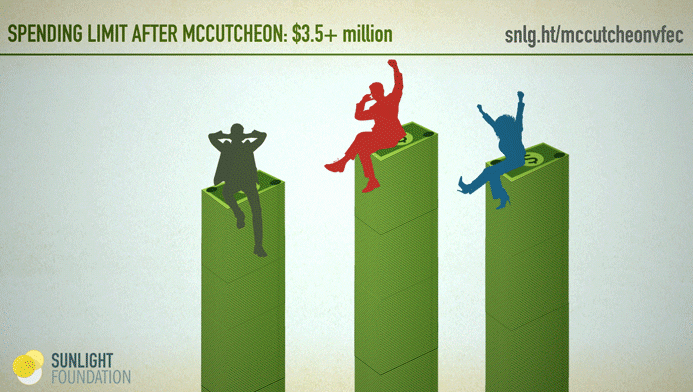Joint fundraisers ballooning after McCutcheon decision

Seven months after the Supreme Court struck down a provision of campaign finance law that limited the total amount that individuals could contribute to campaigns, parties and political action committees, big donors have a host of new options to more conveniently spread their political influence around.
There are 213 new joint fundraising committees this year, a type of committee that allows contributors to write a single big check to be split among multiple candidates.
Before the McCutcheon decision, the maximum number of recipients that could be included in a joint fundraiser stood at seven. Its beneficiaries can include campaigns, parties and leadership PACs.
Since April 2, when the case was decided, 11 new PACs were formed with more than seven beneficiaries, a Sunlight analysis found. Two of these new “super joints” include more than 20 recipient committees.
Plenty of generous donors are exercising their new freedoms, writing six-figure checks to PACs like the Democratic Grassroots Victory Project — a 26-recipient super joint — to which 12 donors combined to give $1.1 million in September.
Some of the jumbo JFC’s biggest donors include longtime Democratic campaign benefactor Donald Sussman as well as Ian Simmons, a Massachusetts investor whose $150,000 was the largest hard-money check since the passage of the McCain-Feingold Act, according to the Center for Responsive Politics and reported by the Washington Post.
Recipients of the big donors’ largesse still get money in limited amounts. For example, the maximum amount a donor can give to a candidate — even when using a super joint committee — is $2,600 per election. PACs can get $5,000, state party committees $10,000 and national party committees $32,400. But with the new super joints, a big contribution can benefit a candidate in multiple ways. A group like the GOP’s Targeted State Victory funnels money into 13 state party committees and the National Republican Senatorial Campaign Committee. Those committees, in turn, can use their donations to run independent expenditures or get out the vote operations to benefit a candidate.
It’s a recurring set-up in the new breed of super joints on our list and the multiple recipients ensure more resources for candidates and more pull for donors that can foot the bill.
The fact that so many party committees are beneficiaries of the new joint fundraising committees suggests that party officials — who often organize these vehicles — will gain greater clout, as former Sunlight Senior Fellow Lee Drutman prognosticated at the time of the Supreme Court’s decision.
An invitation to a recent Grassroots Victory fundraiser headlined by Hillary Clinton and coordinated by the Democratic Senatorial Campaign Committee helpfully reminds donors that they can legally give up to $211,200 to help the cause.
Reception & Dinner for Mark Udall, Bruce Braley, Mary Landrieu, Democratic Senatorial Campaign Committee, J… by Sunlight Foundation
The ruling in McCutcheon v. Federal Election Commission marked another significant shift in the campaign finance landscape that began with the Citizens United decision in 2010. McCutcheon opened another avenue for big donors to extend their influence.
The Sunlight Foundation was one of several organizations that follow transparency and money in politics issues to criticize the court’s decision to lift biennial limits on campaign contributions.

